Effective Risk Management Strategies for Non-Profit Organizations
VerifiedAdded on 2023/05/26
|21
|3658
|394
Report
AI Summary
This report provides a comprehensive analysis of risk management for NGOs, emphasizing the identification, analysis, and mitigation of potential risks that can impact their operations and project implementation. It outlines a step-by-step approach to risk management, covering key components such as building context, risk assessment, risk analysis, risk evaluation, and risk treatment. The report further discusses the benefits of effective risk management, including improved decision-making, enhanced resilience, and increased stakeholder confidence. It categorizes risks into contextual, programmatic, and organizational areas, providing guidance on measuring risk probability and consequences through the development of a risk matrix. The importance of recording risk information in a risk register is highlighted, along with a model for actualizing risk management processes. The discussion section details the five key steps of an effective risk management process: risk identification, analysis, evaluation, response planning, and monitoring. Finally, the report presents the pros and cons of risk management at local, national, and international levels, concluding with general recommendations for NGOs to enhance their risk management practices.
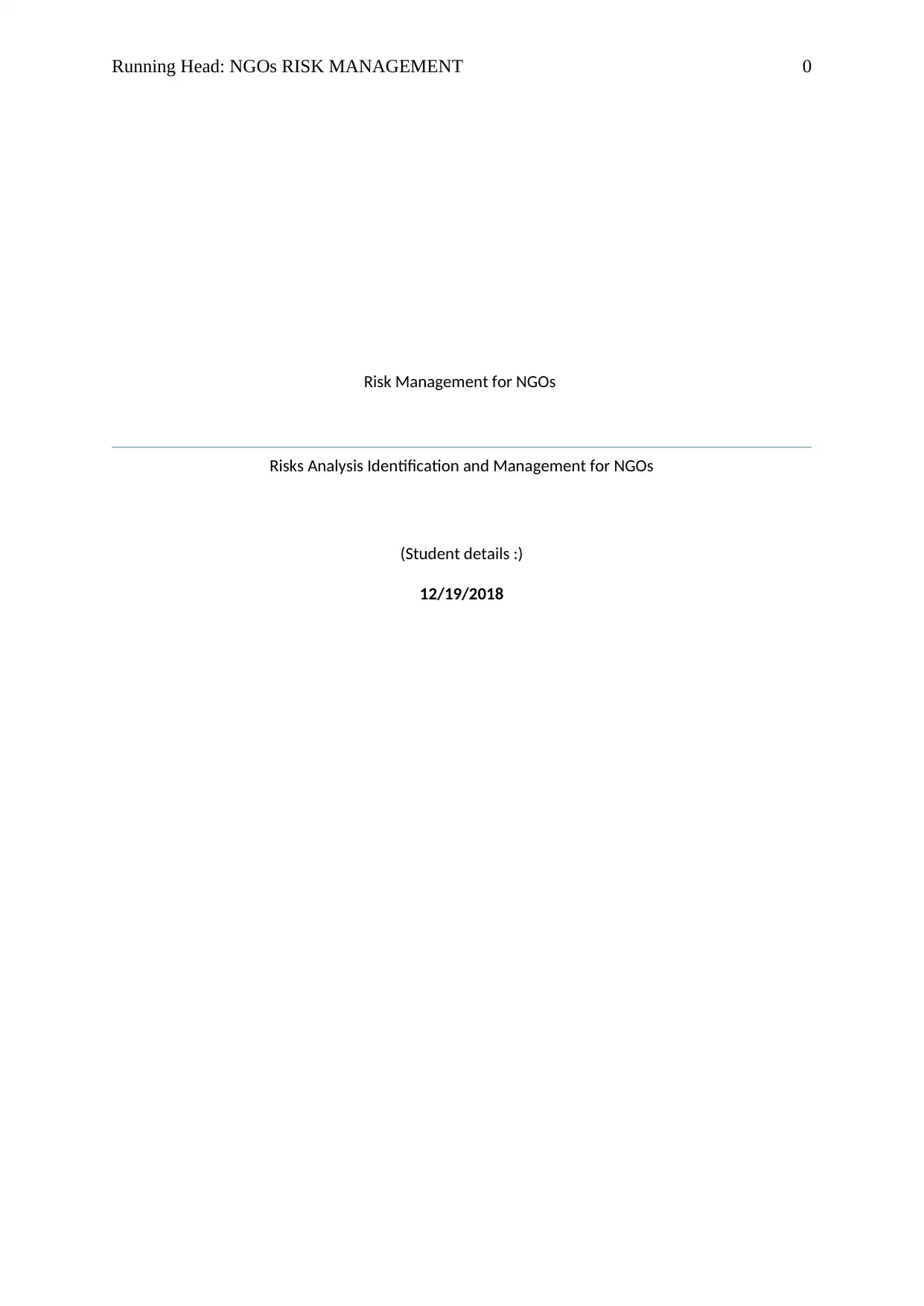
Running Head: NGOs RISK MANAGEMENT 0
Risk Management for NGOs
Risks Analysis Identification and Management for NGOs
(Student details :)
12/19/2018
Risk Management for NGOs
Risks Analysis Identification and Management for NGOs
(Student details :)
12/19/2018
Paraphrase This Document
Need a fresh take? Get an instant paraphrase of this document with our AI Paraphraser
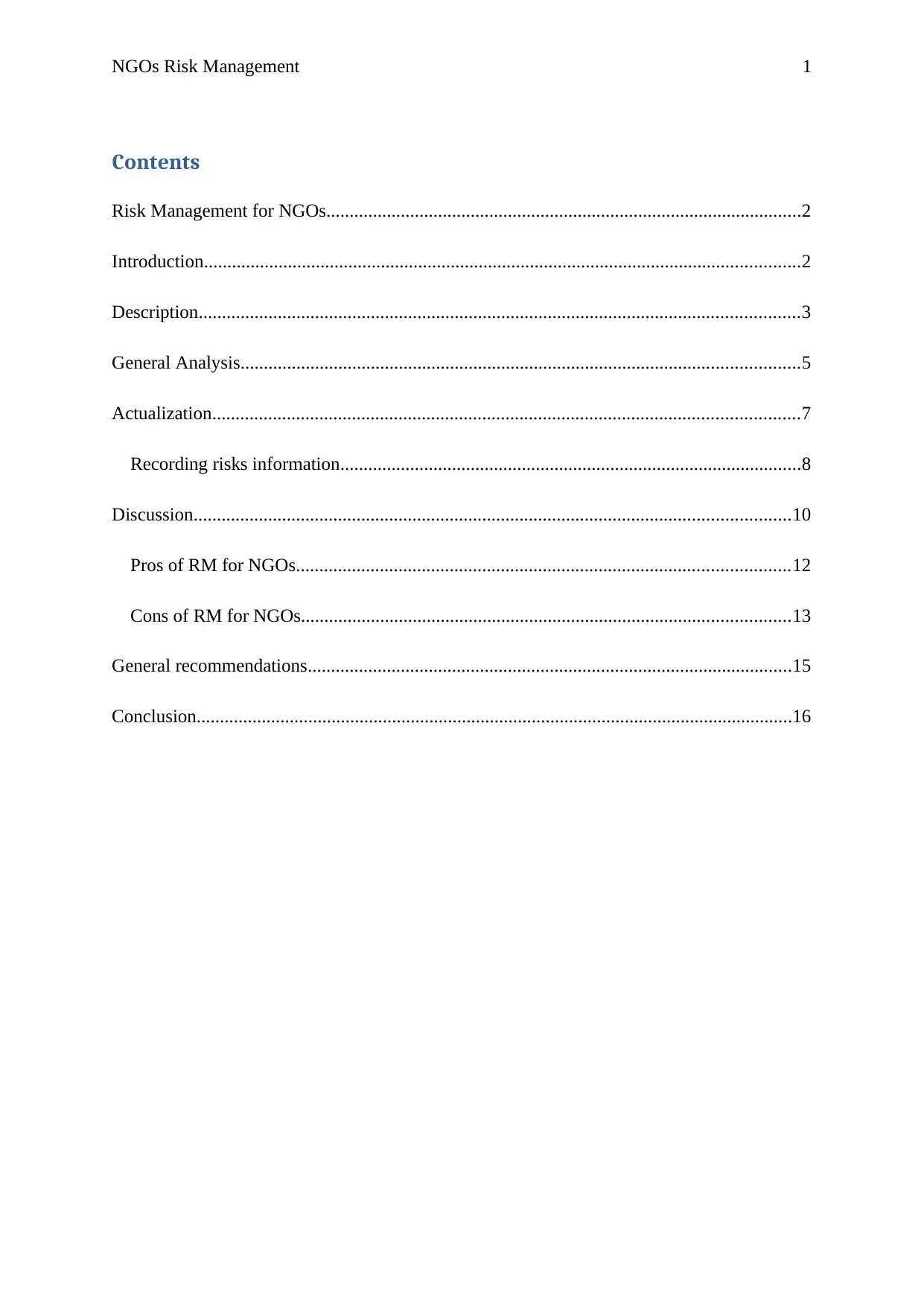
NGOs Risk Management 1
Contents
Risk Management for NGOs......................................................................................................2
Introduction................................................................................................................................2
Description.................................................................................................................................3
General Analysis........................................................................................................................5
Actualization..............................................................................................................................7
Recording risks information...................................................................................................8
Discussion................................................................................................................................10
Pros of RM for NGOs..........................................................................................................12
Cons of RM for NGOs.........................................................................................................13
General recommendations........................................................................................................15
Conclusion................................................................................................................................16
Contents
Risk Management for NGOs......................................................................................................2
Introduction................................................................................................................................2
Description.................................................................................................................................3
General Analysis........................................................................................................................5
Actualization..............................................................................................................................7
Recording risks information...................................................................................................8
Discussion................................................................................................................................10
Pros of RM for NGOs..........................................................................................................12
Cons of RM for NGOs.........................................................................................................13
General recommendations........................................................................................................15
Conclusion................................................................................................................................16

NGOs Risk Management 2
Risk Management for NGOs
Introduction
This essay is focused on identification of probable risks occurred for NGOs while
implementing projects along with providing strategies or solutions for mitigating those risks
effectively. As we know that Non-government Organizations (herein after referred as NGOs)
are functioning in a specific environment like conflicts, poverty, natural disaster, under
donors funds and restrictions, local government rules, compliance between international and
national laws are facing so many risks hence this discussion is an attempt for assessing those
risks and finding their effective solutions (AustralianGovernment, 2008).
Risk can be defined as the common thinking about what might go wrong in a NGO or
any other organization (Gartner, 2018). In this context, more precise definition of risk is ‘the
effects of uncertainty on NGOs objectives’. With the change in an internal dynamics as well
as external environment in which an organization operates, potential risks arrive, vanish or
evolve. Hence risk management is the process of coordinated activities for controlling or
reducing risks. During risk management (RM), anticipating risks is the first step, then it aims
at averting risks and finally at optimizing risks’ impact if they do happen (Colquitt, Lepine,
Wessaon, & Gellatly, 2011).
In this way, this document is a direction for all those NGOs staff includes directors,
directors, senior staff, managers and any other staff who really want to manage their risks as
well as work well (SHF, 2018). This discussion will help in formulating a risk management
framework or policy for identifying, monitoring as well as managing risks in NGOs by
providing a step-by-step approach. Step-by-step approach may contain description, general
Risk Management for NGOs
Introduction
This essay is focused on identification of probable risks occurred for NGOs while
implementing projects along with providing strategies or solutions for mitigating those risks
effectively. As we know that Non-government Organizations (herein after referred as NGOs)
are functioning in a specific environment like conflicts, poverty, natural disaster, under
donors funds and restrictions, local government rules, compliance between international and
national laws are facing so many risks hence this discussion is an attempt for assessing those
risks and finding their effective solutions (AustralianGovernment, 2008).
Risk can be defined as the common thinking about what might go wrong in a NGO or
any other organization (Gartner, 2018). In this context, more precise definition of risk is ‘the
effects of uncertainty on NGOs objectives’. With the change in an internal dynamics as well
as external environment in which an organization operates, potential risks arrive, vanish or
evolve. Hence risk management is the process of coordinated activities for controlling or
reducing risks. During risk management (RM), anticipating risks is the first step, then it aims
at averting risks and finally at optimizing risks’ impact if they do happen (Colquitt, Lepine,
Wessaon, & Gellatly, 2011).
In this way, this document is a direction for all those NGOs staff includes directors,
directors, senior staff, managers and any other staff who really want to manage their risks as
well as work well (SHF, 2018). This discussion will help in formulating a risk management
framework or policy for identifying, monitoring as well as managing risks in NGOs by
providing a step-by-step approach. Step-by-step approach may contain description, general
⊘ This is a preview!⊘
Do you want full access?
Subscribe today to unlock all pages.

Trusted by 1+ million students worldwide
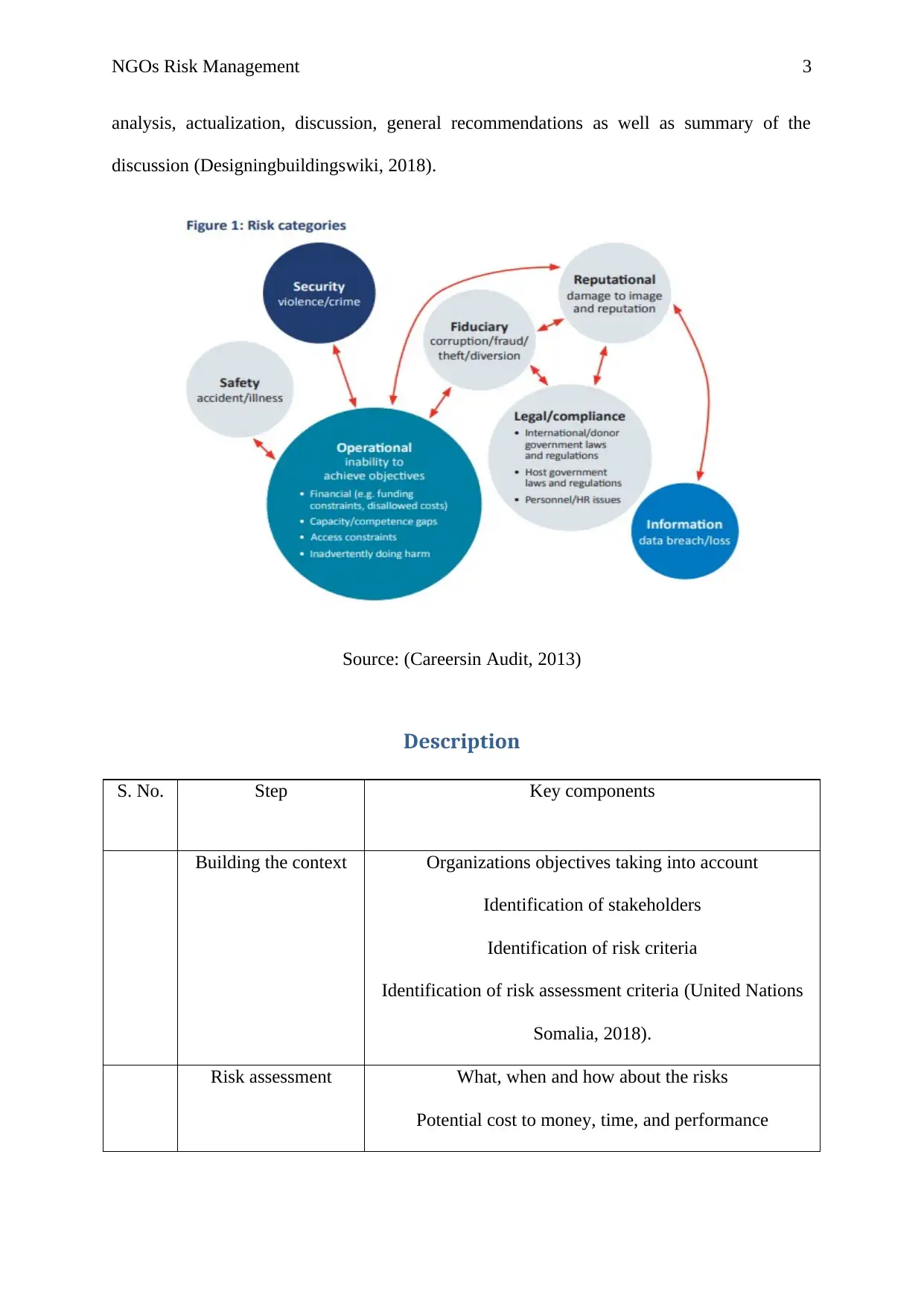
NGOs Risk Management 3
analysis, actualization, discussion, general recommendations as well as summary of the
discussion (Designingbuildingswiki, 2018).
Source: (Careersin Audit, 2013)
Description
S. No. Step Key components
Building the context Organizations objectives taking into account
Identification of stakeholders
Identification of risk criteria
Identification of risk assessment criteria (United Nations
Somalia, 2018).
Risk assessment What, when and how about the risks
Potential cost to money, time, and performance
analysis, actualization, discussion, general recommendations as well as summary of the
discussion (Designingbuildingswiki, 2018).
Source: (Careersin Audit, 2013)
Description
S. No. Step Key components
Building the context Organizations objectives taking into account
Identification of stakeholders
Identification of risk criteria
Identification of risk assessment criteria (United Nations
Somalia, 2018).
Risk assessment What, when and how about the risks
Potential cost to money, time, and performance
Paraphrase This Document
Need a fresh take? Get an instant paraphrase of this document with our AI Paraphraser

NGOs Risk Management 4
Impacts of each risk
Source of the risk
Risk analysis Analysis of existing controls
Consequences of the risk been considered
Application of likelihood criteria
Development of risk matrix
Risk evaluation Comparison of the risk against se criteria
Development of guidelines about retention and escalation
Making decision for treating risk
Continue monitoring and reviewing risk
Risk treatment Identification of treatment options
Assessment of all treatment options
Implementation of treatment plans
Analysis and evaluation of residual risks
Consideration of consultation and communication
requirements (Reference for Business, 2018).
The modern world’s environment in which NGOs are operating is evolving quickly,
as is the process of the risk management functions as well as the procedure of making
decisions about risks (Chenhall, Hall, & Smith, 2010). The changes of the modern world are
affecting not only NGOs but also the community which is served and the organizations those
are funding them (Clarke, 2017). For the NGO’s success in terms of executing their mission
as well as accomplishing their long-term goals, NGOs must keep pace with modifications in
the whole political, economic and cultural environment of the risk management practice so
Impacts of each risk
Source of the risk
Risk analysis Analysis of existing controls
Consequences of the risk been considered
Application of likelihood criteria
Development of risk matrix
Risk evaluation Comparison of the risk against se criteria
Development of guidelines about retention and escalation
Making decision for treating risk
Continue monitoring and reviewing risk
Risk treatment Identification of treatment options
Assessment of all treatment options
Implementation of treatment plans
Analysis and evaluation of residual risks
Consideration of consultation and communication
requirements (Reference for Business, 2018).
The modern world’s environment in which NGOs are operating is evolving quickly,
as is the process of the risk management functions as well as the procedure of making
decisions about risks (Chenhall, Hall, & Smith, 2010). The changes of the modern world are
affecting not only NGOs but also the community which is served and the organizations those
are funding them (Clarke, 2017). For the NGO’s success in terms of executing their mission
as well as accomplishing their long-term goals, NGOs must keep pace with modifications in
the whole political, economic and cultural environment of the risk management practice so
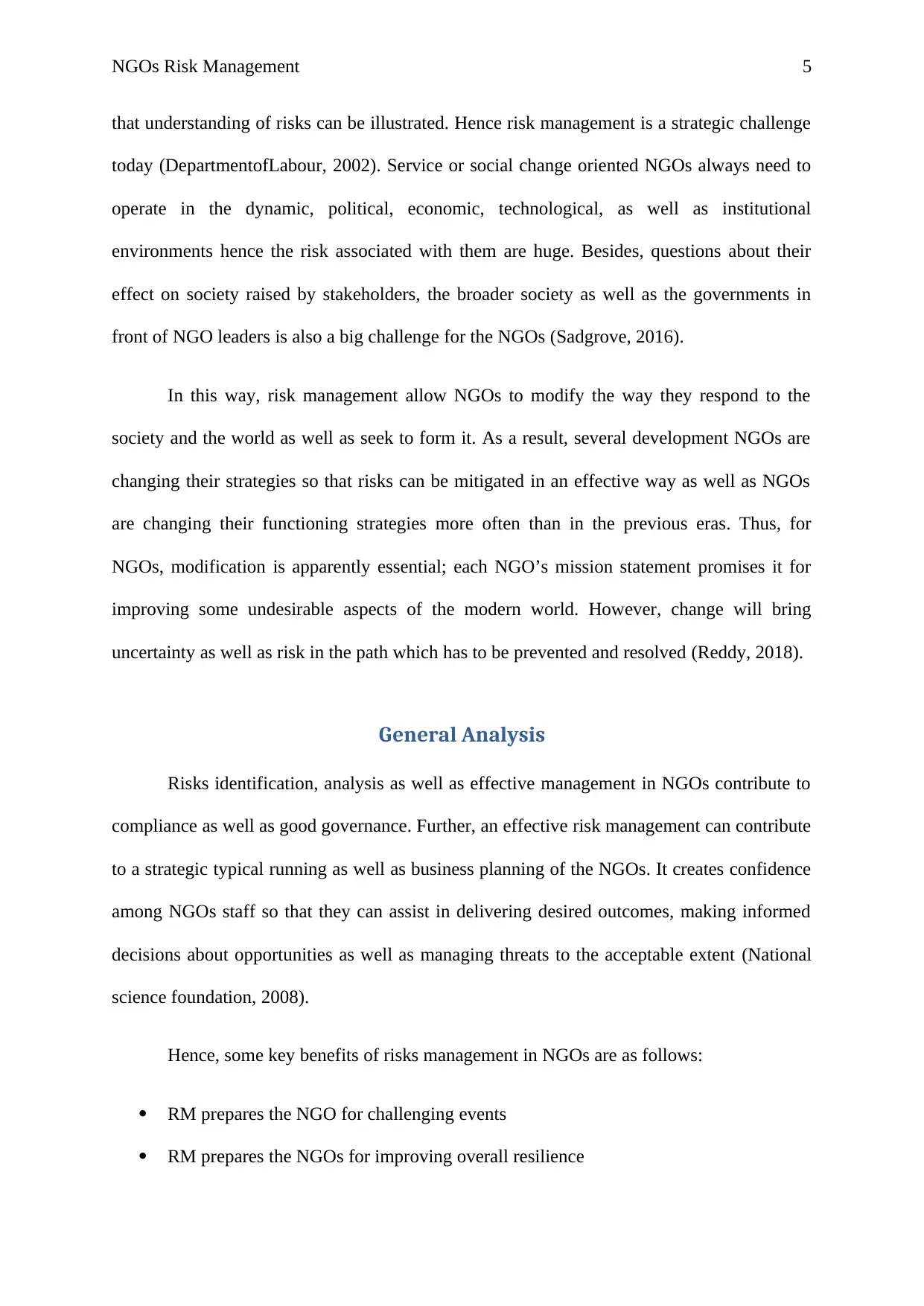
NGOs Risk Management 5
that understanding of risks can be illustrated. Hence risk management is a strategic challenge
today (DepartmentofLabour, 2002). Service or social change oriented NGOs always need to
operate in the dynamic, political, economic, technological, as well as institutional
environments hence the risk associated with them are huge. Besides, questions about their
effect on society raised by stakeholders, the broader society as well as the governments in
front of NGO leaders is also a big challenge for the NGOs (Sadgrove, 2016).
In this way, risk management allow NGOs to modify the way they respond to the
society and the world as well as seek to form it. As a result, several development NGOs are
changing their strategies so that risks can be mitigated in an effective way as well as NGOs
are changing their functioning strategies more often than in the previous eras. Thus, for
NGOs, modification is apparently essential; each NGO’s mission statement promises it for
improving some undesirable aspects of the modern world. However, change will bring
uncertainty as well as risk in the path which has to be prevented and resolved (Reddy, 2018).
General Analysis
Risks identification, analysis as well as effective management in NGOs contribute to
compliance as well as good governance. Further, an effective risk management can contribute
to a strategic typical running as well as business planning of the NGOs. It creates confidence
among NGOs staff so that they can assist in delivering desired outcomes, making informed
decisions about opportunities as well as managing threats to the acceptable extent (National
science foundation, 2008).
Hence, some key benefits of risks management in NGOs are as follows:
RM prepares the NGO for challenging events
RM prepares the NGOs for improving overall resilience
that understanding of risks can be illustrated. Hence risk management is a strategic challenge
today (DepartmentofLabour, 2002). Service or social change oriented NGOs always need to
operate in the dynamic, political, economic, technological, as well as institutional
environments hence the risk associated with them are huge. Besides, questions about their
effect on society raised by stakeholders, the broader society as well as the governments in
front of NGO leaders is also a big challenge for the NGOs (Sadgrove, 2016).
In this way, risk management allow NGOs to modify the way they respond to the
society and the world as well as seek to form it. As a result, several development NGOs are
changing their strategies so that risks can be mitigated in an effective way as well as NGOs
are changing their functioning strategies more often than in the previous eras. Thus, for
NGOs, modification is apparently essential; each NGO’s mission statement promises it for
improving some undesirable aspects of the modern world. However, change will bring
uncertainty as well as risk in the path which has to be prevented and resolved (Reddy, 2018).
General Analysis
Risks identification, analysis as well as effective management in NGOs contribute to
compliance as well as good governance. Further, an effective risk management can contribute
to a strategic typical running as well as business planning of the NGOs. It creates confidence
among NGOs staff so that they can assist in delivering desired outcomes, making informed
decisions about opportunities as well as managing threats to the acceptable extent (National
science foundation, 2008).
Hence, some key benefits of risks management in NGOs are as follows:
RM prepares the NGO for challenging events
RM prepares the NGOs for improving overall resilience
⊘ This is a preview!⊘
Do you want full access?
Subscribe today to unlock all pages.

Trusted by 1+ million students worldwide
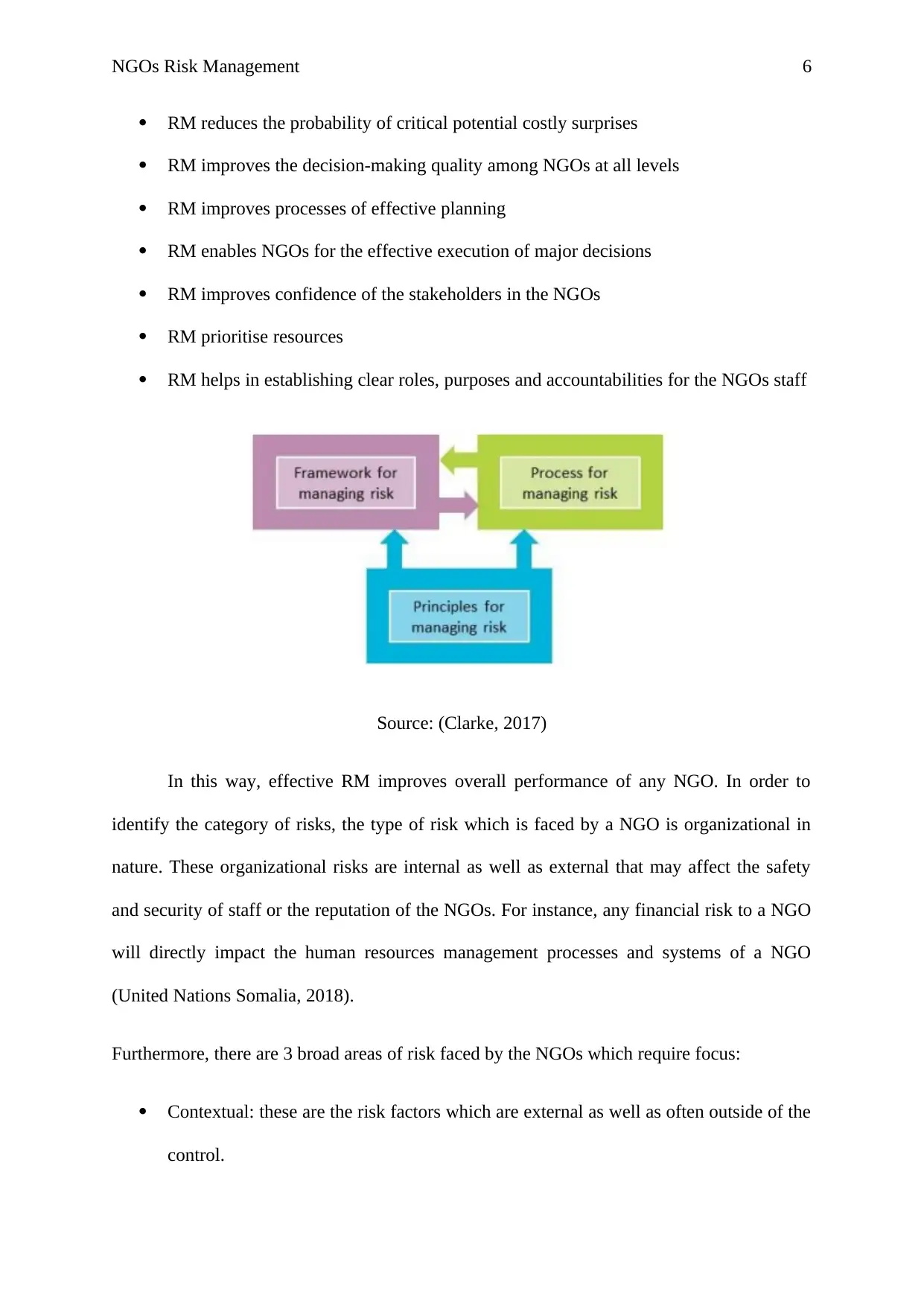
NGOs Risk Management 6
RM reduces the probability of critical potential costly surprises
RM improves the decision-making quality among NGOs at all levels
RM improves processes of effective planning
RM enables NGOs for the effective execution of major decisions
RM improves confidence of the stakeholders in the NGOs
RM prioritise resources
RM helps in establishing clear roles, purposes and accountabilities for the NGOs staff
Source: (Clarke, 2017)
In this way, effective RM improves overall performance of any NGO. In order to
identify the category of risks, the type of risk which is faced by a NGO is organizational in
nature. These organizational risks are internal as well as external that may affect the safety
and security of staff or the reputation of the NGOs. For instance, any financial risk to a NGO
will directly impact the human resources management processes and systems of a NGO
(United Nations Somalia, 2018).
Furthermore, there are 3 broad areas of risk faced by the NGOs which require focus:
Contextual: these are the risk factors which are external as well as often outside of the
control.
RM reduces the probability of critical potential costly surprises
RM improves the decision-making quality among NGOs at all levels
RM improves processes of effective planning
RM enables NGOs for the effective execution of major decisions
RM improves confidence of the stakeholders in the NGOs
RM prioritise resources
RM helps in establishing clear roles, purposes and accountabilities for the NGOs staff
Source: (Clarke, 2017)
In this way, effective RM improves overall performance of any NGO. In order to
identify the category of risks, the type of risk which is faced by a NGO is organizational in
nature. These organizational risks are internal as well as external that may affect the safety
and security of staff or the reputation of the NGOs. For instance, any financial risk to a NGO
will directly impact the human resources management processes and systems of a NGO
(United Nations Somalia, 2018).
Furthermore, there are 3 broad areas of risk faced by the NGOs which require focus:
Contextual: these are the risk factors which are external as well as often outside of the
control.
Paraphrase This Document
Need a fresh take? Get an instant paraphrase of this document with our AI Paraphraser
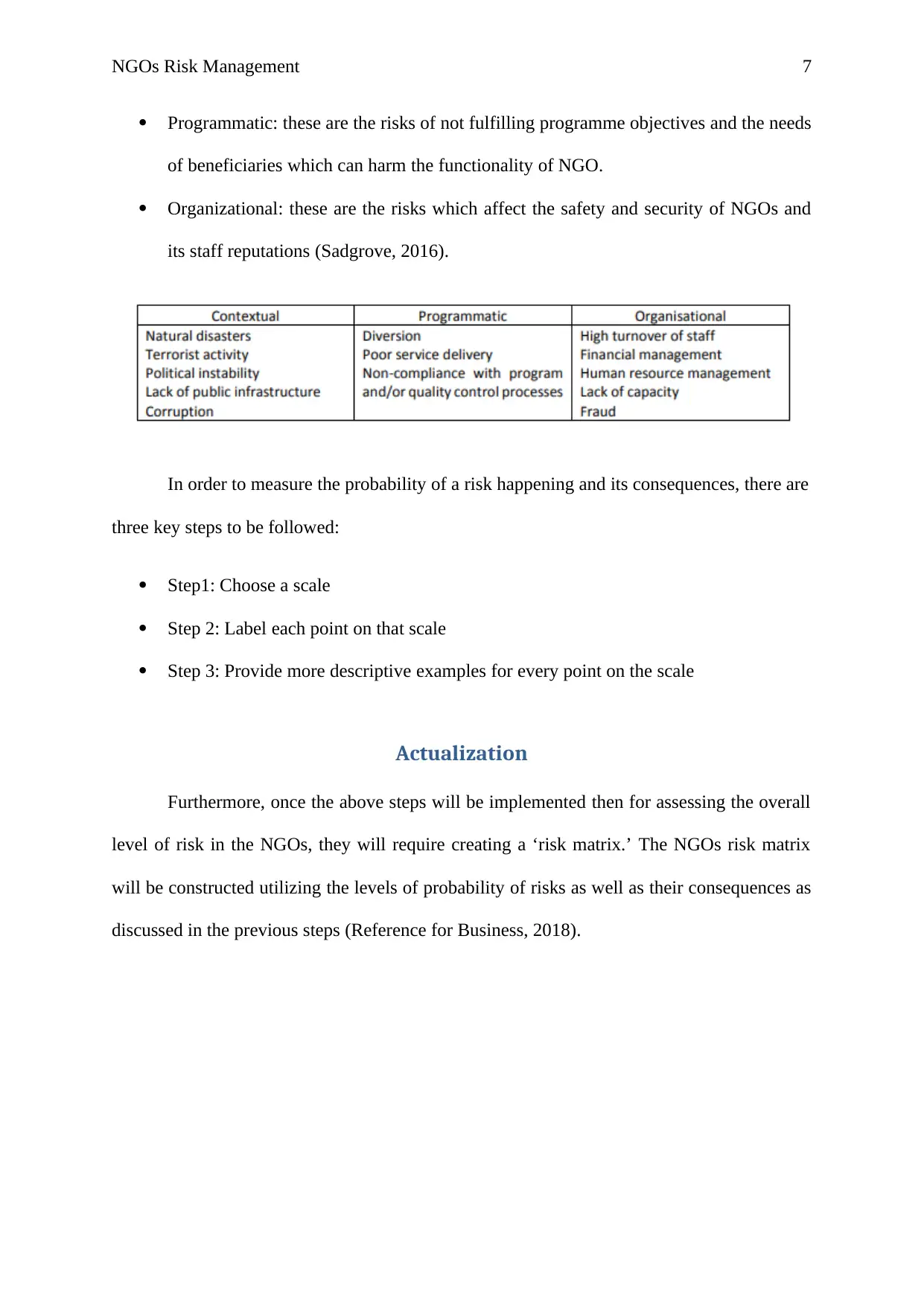
NGOs Risk Management 7
Programmatic: these are the risks of not fulfilling programme objectives and the needs
of beneficiaries which can harm the functionality of NGO.
Organizational: these are the risks which affect the safety and security of NGOs and
its staff reputations (Sadgrove, 2016).
In order to measure the probability of a risk happening and its consequences, there are
three key steps to be followed:
Step1: Choose a scale
Step 2: Label each point on that scale
Step 3: Provide more descriptive examples for every point on the scale
Actualization
Furthermore, once the above steps will be implemented then for assessing the overall
level of risk in the NGOs, they will require creating a ‘risk matrix.’ The NGOs risk matrix
will be constructed utilizing the levels of probability of risks as well as their consequences as
discussed in the previous steps (Reference for Business, 2018).
Programmatic: these are the risks of not fulfilling programme objectives and the needs
of beneficiaries which can harm the functionality of NGO.
Organizational: these are the risks which affect the safety and security of NGOs and
its staff reputations (Sadgrove, 2016).
In order to measure the probability of a risk happening and its consequences, there are
three key steps to be followed:
Step1: Choose a scale
Step 2: Label each point on that scale
Step 3: Provide more descriptive examples for every point on the scale
Actualization
Furthermore, once the above steps will be implemented then for assessing the overall
level of risk in the NGOs, they will require creating a ‘risk matrix.’ The NGOs risk matrix
will be constructed utilizing the levels of probability of risks as well as their consequences as
discussed in the previous steps (Reference for Business, 2018).

NGOs Risk Management 8
Source: (Careersin Audit, 2013)
Hence, overall risks measurement is obtained from the blend of probability and
consequences. It increases from the minimum point situated in the bottom left hand corner to
the maximum point situated in the top right hand corner. According to the above instructions
every NGO will need to develop a risk matrix to suit their organization (SHF, 2018).
Moreover, decision-making regarding escalation, retention and treatment comes into
the next step of the risk management procedure of NGOs (Reddy, 2018).
Source: (United Nations Somalia, 2018)
Source: (Careersin Audit, 2013)
Hence, overall risks measurement is obtained from the blend of probability and
consequences. It increases from the minimum point situated in the bottom left hand corner to
the maximum point situated in the top right hand corner. According to the above instructions
every NGO will need to develop a risk matrix to suit their organization (SHF, 2018).
Moreover, decision-making regarding escalation, retention and treatment comes into
the next step of the risk management procedure of NGOs (Reddy, 2018).
Source: (United Nations Somalia, 2018)
⊘ This is a preview!⊘
Do you want full access?
Subscribe today to unlock all pages.

Trusted by 1+ million students worldwide
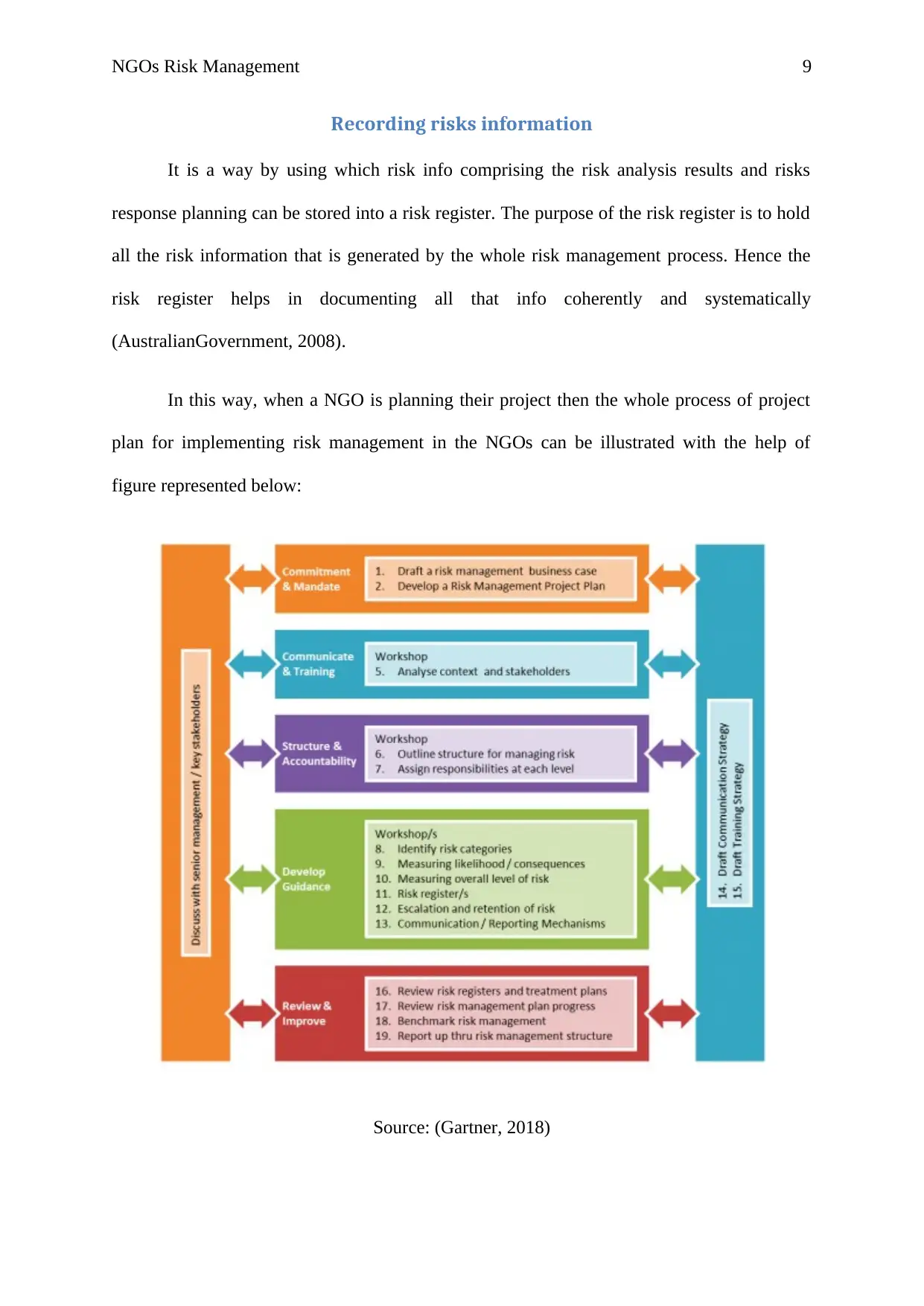
NGOs Risk Management 9
Recording risks information
It is a way by using which risk info comprising the risk analysis results and risks
response planning can be stored into a risk register. The purpose of the risk register is to hold
all the risk information that is generated by the whole risk management process. Hence the
risk register helps in documenting all that info coherently and systematically
(AustralianGovernment, 2008).
In this way, when a NGO is planning their project then the whole process of project
plan for implementing risk management in the NGOs can be illustrated with the help of
figure represented below:
Source: (Gartner, 2018)
Recording risks information
It is a way by using which risk info comprising the risk analysis results and risks
response planning can be stored into a risk register. The purpose of the risk register is to hold
all the risk information that is generated by the whole risk management process. Hence the
risk register helps in documenting all that info coherently and systematically
(AustralianGovernment, 2008).
In this way, when a NGO is planning their project then the whole process of project
plan for implementing risk management in the NGOs can be illustrated with the help of
figure represented below:
Source: (Gartner, 2018)
Paraphrase This Document
Need a fresh take? Get an instant paraphrase of this document with our AI Paraphraser

NGOs Risk Management 10
Therefore, the above model figure is demonstrating the actualization that is how the
specific theoretical topics apply to reality and model a risk management process for NGOs.
Hence, a clear illustration of RM and how it is associated to the real life among NGOs is
illustrated in the above figure.
Therefore, the above model figure is demonstrating the actualization that is how the
specific theoretical topics apply to reality and model a risk management process for NGOs.
Hence, a clear illustration of RM and how it is associated to the real life among NGOs is
illustrated in the above figure.

NGOs Risk Management 11
Discussion
In whole, the RM process is a set of activities the NGOs carry out for identifying,
assessing, managing and monitoring the risks to which NGO may get exposed (Clarke, 2017).
In this context, below figure is outlining the major steps involved in the RM process of the
NGOs:
Source: (Sadgrove, 2016)
Hence, there are 5 key steps of an effective RM process for NGOs:
Identification of risks
Analysis of risks
Evaluation of the risks
Planning of risk response
Monitoring and review of the risks.
Additionally, in order to accomplish any project or task in the NGOs, senior managers
in of NGOs usually manage their ideas on the basis of four major factors of RM process
(Sadgrove, 2016). There are these major steps which assist NGOs in managing the risks in
their organization. They are as follows:
Discussion
In whole, the RM process is a set of activities the NGOs carry out for identifying,
assessing, managing and monitoring the risks to which NGO may get exposed (Clarke, 2017).
In this context, below figure is outlining the major steps involved in the RM process of the
NGOs:
Source: (Sadgrove, 2016)
Hence, there are 5 key steps of an effective RM process for NGOs:
Identification of risks
Analysis of risks
Evaluation of the risks
Planning of risk response
Monitoring and review of the risks.
Additionally, in order to accomplish any project or task in the NGOs, senior managers
in of NGOs usually manage their ideas on the basis of four major factors of RM process
(Sadgrove, 2016). There are these major steps which assist NGOs in managing the risks in
their organization. They are as follows:
⊘ This is a preview!⊘
Do you want full access?
Subscribe today to unlock all pages.

Trusted by 1+ million students worldwide
1 out of 21
Related Documents
Your All-in-One AI-Powered Toolkit for Academic Success.
+13062052269
info@desklib.com
Available 24*7 on WhatsApp / Email
![[object Object]](/_next/static/media/star-bottom.7253800d.svg)
Unlock your academic potential
Copyright © 2020–2025 A2Z Services. All Rights Reserved. Developed and managed by ZUCOL.





